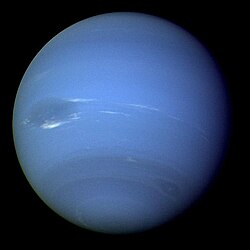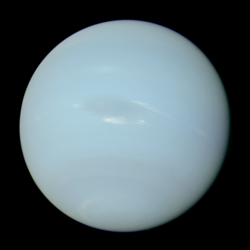Neptune
| It's not rocket science, it's... Astronomy |
| The Final Frontier |
| The abyss stares back |
“”A large storm rages in the planet, called the "Great Dark Spot". It is the lens. Neptune has been mutated.
|
| —Gemini Home Entertainment, Our Solar System |
Neptune is the eighth furthest planet from the Sun in the Solar system and the fourth largest. Since the "demotion" of Pluto it is the farthest known from the Sun. It is named after the god of water and the seas in Roman mythology (equivalent to Poseidon in Greek mythology, whose name is used in![]() Greece to refer to this planet instead), the brother of Jupiter and Pluto. Like Uranus, Neptune is an "ice giant" and not a "gas giant" with just its outer layers being gaseous while most of the planet is an icy mantle made of water, ammonia, and methane that surrounds a solid rocky core. However, Neptune's interior is much hotter than that of Uranus which translates to a much higher atmospheric activity.
Greece to refer to this planet instead), the brother of Jupiter and Pluto. Like Uranus, Neptune is an "ice giant" and not a "gas giant" with just its outer layers being gaseous while most of the planet is an icy mantle made of water, ammonia, and methane that surrounds a solid rocky core. However, Neptune's interior is much hotter than that of Uranus which translates to a much higher atmospheric activity.
Discovered on 23 September 1846, Neptune was the second planet discovered in modern times. Unlike Uranus, its discovery was the result of mathematical prediction rather than chance observation. Unexpected changes in the orbit of Uranus led astronomers to deduce the gravitational perturbation of an unknown planet. Neptune was found within a degree of the predicted position. Its blue color led to it being given the name of the god of the seas. Its largest moon Triton was found shortly thereafter but none of the planet's other 13 moons were discovered before the 20th century. Neptune has been visited by only one spacecraft, Voyager 2, which flew by the planet on 25 August 1989.
The Great Dark Spot[edit]
Out-of-date books and web sites (including this one, see image top right) might lead you to believe that Neptune has a Great Dark Spot, in the southern hemisphere. Imagery you will see of this huge storm will date back to the close pass of Voyager 2 in 1989. However, later imagery (principally by the Hubble Space Telescope) shows that the storm, first observed at ~22°S, wandered north and then disappeared altogether. Latest data shows a new, smaller dark spot in the Northern hemisphere.
Triton[edit]
Triton is the first-known and largest moon in the solar system to orbit its parent planet backwards, and Voyager 2 has shown it has a very tenuous atmosphere of primarily nitrogen. Its surface is very young with few impact craters, cryovolcanism, as well as nitrogen geysers. It is the only Neptunian moon known to be round under its own gravity.
Triton's days are numbered: Neptune's tidal forces are causing it to spiral inwards and in up to 3.6 billion years it's expected said moon will pass Neptune's Roche limit and will be torn apart, leaving behind a dense and magnificent Saturn-like ring system, albeit smaller as Neptune is not as large as Saturn.
The generally accepted explanation for Triton's orbital oddities is that it did not form around Neptune. Rather, it began its existence as one of the Kuiper Belt's dwarf planets. Computer simulations show that Triton should not have been captured if it was a single object; it should have been ejected into the Scattered Disk instead. Further simulations show that the existence of a binary partner similar to the Pluto-Charon system would have given Triton the angular momentum necessary to make capture likely. This event wreaked havoc on Neptune's original moon system and as a result astronomers cannot currently predict what a typical ice giant moon system looks like even if Uranus' system, for all the peculiarities of the planet itself, seems to be normal, not disrupted in such a way.
Less blue than you thought[edit]
In 2024, the University of Oxford decided to drop a massive bummer and remind everyone that Neptune's color is not so different from Uranus's color unlike what many pictures (including the one at the head of this article) would want you to believe.[1]
This wasn't even news, at least not to planetary scientists. People just forgot about it.[2]
In music[edit]
"Neptune the Mystic" is the seventh and final movement in The Planets![]() by Gustav Holst (Earth was not included, and Pluto had yet to be discovered; when it was, Holst, (rightly) feeling The Planets unfairly overshadowed his other works, refused to write a movement for Pluto). A spectacular version of this piece, executed by Isao Tomita on the Moog synthesizer in 1976, can be seen on YouTube here, accompanied by images from Voyager II.
by Gustav Holst (Earth was not included, and Pluto had yet to be discovered; when it was, Holst, (rightly) feeling The Planets unfairly overshadowed his other works, refused to write a movement for Pluto). A spectacular version of this piece, executed by Isao Tomita on the Moog synthesizer in 1976, can be seen on YouTube here, accompanied by images from Voyager II.
References[edit]
- ↑ Irwin, Patrick G J; Dobinson, Jack; James, Arjuna; Teanby, Nicholas A; Simon, Amy A; Fletcher, Leigh N; Roman, Michael T; Orton, Glenn S; Wong, Michael H; Toledo, Daniel; Pérez-Hoyos, Santiago; Beck, Julie (2023-12-23). "Modelling the seasonal cycle of Uranus's colour and magnitude, and comparison with Neptune". Monthly Notices of the Royal Astronomical Society. 527 (4): 11521–11538. doi:10.1093/mnras/stad3761. ISSN 0035-8711.
{{cite journal}}: CS1 maint: unflagged free DOI (link) - ↑ Sharmila Kuthunur (January 4, 2024). "Uranus and Neptune are actually similar blues, 'true' color images reveal". Space.com.


